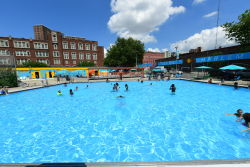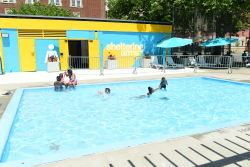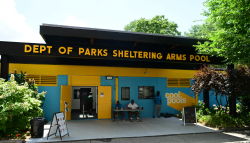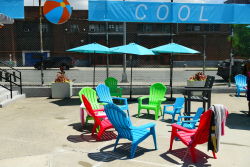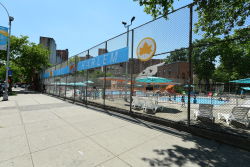Sheltering Arms Playground
Sheltering Arms Pool
For outdoor pool details, including hours and rules, please visit our Free Outdoor Pools page.
Acquired in 1945 from the eponymous institution, Sheltering Arms Pool was once the site of a free asylum for homeless children. In 1864 Reverend Thomas M. Peters, then Rector of St. Michael’s Protestant Episcopal Church, organized the Sheltering Arms out of his own home near West 100th Street.
The Sheltering Arms established a haven for “the children in the midst,” for whom other charitable institutions in 19th century New York failed to provide. Some were rejected due to incurable illnesses, some were abandoned, and others were so-called “half-orphans,” whose parents required temporary assistance while striving to overcome abject poverty or other adversities. The organization relocated its services to West 129th Street and Tenth Avenue after Broadway was cut through Peters’ grounds. On March 6, 1869, the cornerstone was laid at this site, and close to a year later, the children of the Sheltering Arms moved into their first custom-built home on February 5, 1870.
The building’s plan was inspired by the innovative “rough house” cottages in Wichern, near Hamburg, Germany, which dispersed children into equally numbered “families.” Manhattan’s prohibitive land values compelled an alternative design by prominent architect Charles C. Haight who created a single, two-story, brick Gothic Revival building composed of five sections, whose slated mansard roof housed a third story. Unlike many institutions, the Sheltering Arms did not require parents to surrender their children for good. It received up to 120 children at a time from infancy to the age of 14, “subject to the call of their parents or relatives,” regardless of creed or nationality.
This area was then known as Manhattanville, established in 1806 by merchant Jacob Schieffelin (1757-1835), local Quakers, and others. The village straddled both sides of present-day 125th Street along the Bloomingdale Road (now Broadway). Its picturesque valley opening onto the Hudson River was the village counterpart to Harlem on the Harlem River.The partnership helped both towns to flourish as popular suburban retreats from the crowded city. By 1850, Manhattanville was a distinct residential, manufacturing, and transportation hub and the first principal northbound station of the new Hudson River Railroad.
The Sheltering Arms grounds also have a significant history. In 1851, the first Manhattanville post office had opened on the western point of this triangular block. In the center was the historic St. Mary’s Protestant Episcopal Church which offered the institution free chaplain’s services, and where Rev. Peters was formerly rector. Until St. Mary’s was organized at Manhattanville in 1823, the Dutch Reformed Church had been the only place of worship of any denomination in all of Harlem. Jacob Schieffelin and his wife Hannah Lawrence donated the church lot facing Lawrence Street, now called West 126th Street, where they are buried. In 1831, St. Mary’s became New York’s first “free pew” Episcopal church. Its congregation was racially mixed, and included the widow and children of Alexander Hamilton, the country’s first Secretary of the Treasury; African-American abolitionists; and Daniel F. Tiemann, Mayor of New York City in 1858 and 1859. In 1998, St. Mary’s-Manhattanville was designated a City Historic Landmark. The church is Harlem’s oldest religious institution operating from the same location at which it was founded.
The opening of the Broadway Interborough Rapid Transit (IRT) subway line in 1904 sparked an apartment development boom that caused the exodus of many neighborhood institutions. In 1944, the Sheltering Arms merged with the New York Children’s Foster Home Service to create the Sheltering Arms Children’s Service, whose headquarters today are located on East 29th Street. NYC Parks acquired the land from the Sheltering Arms under Commissioner Robert Moses (1888-1981).
The current facilities at this site, designed by engineer James J. O’Brien in 1968, include a brick men’s and women’s changing pavilion that opens to a 1’3”-deep wading pool, and a larger, 3’5”-deep pool for casual swimming. During the spring of 2001, a renovation of the site was completed. The two handball courts were reconstructed and new play equipment and safety surfacing was installed. New trees and bushes were planted in the garden area. Sheltering Arms Pool not only provides a welcome urban oasis to beat the summer heat, but its name also perpetuates the memory of an institution that opened its arms to protect the city’s most needful residents.
Check out your park's Vital Signs
Clean & Safe
Green & Resilient
Empowered & Engaged Users
Share your feedback or learn more about how this park is part of a
Vital Park System

